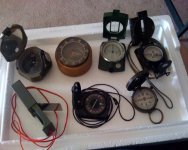Your query prompted me to have a look at the compasses in my hunting daypack... They are a simple Silva Landmark model, with a sighting mirror and rudimentary baseplate with scales, and a now-no-longer offered Silva Model 80 bearing compass that permits a quite precise azimuth, (Bruunton offers an equivalent...), which shows both bearing and its reciprocal on the same view --- very handy when wayfinding in big country such as here "out west", and especially helpful to shoot bearings to find game downed at extreme ranges in open country, probably of little use in big woods. My inclinometer, also Bruunton, I think, is in the lockbox in my truck, and I'm too lazy to get at it, but it is not something I use for navigation, only for measuring the heights of objects, and that of course, requires precise measurement of the base of a right triangle along the ground, and that requires a laser range finder or better yet, a steel tape measure. My altimeter is an older, electronic-display version of an aneroid barometer, once offered by Peet Bros., who seem to have now dropped their line of handheld altimeters, probably because of the prevalence of handheld GPS devices, which, in my experience, are seldom, if ever, very accurate in terms of elevation. My altimeter once played a critical role in establishing our party's position on a wilderness river trip, where, in mountainous canyon country, observation of definitive landmarks for triangulation wasn't feasible, but the ability to determine quite precisely our elevation, and where it's contour line intersected the river on a topo map, gave us a very high confidence position fix. In any case, it may be worthwhile to learn of any magnetic anomalies, such as are common in Michigan's Upper Peninsula, and I've found, north of McNary, AZ, where magnetic compasses can go haywire ...
 ) my orienteering compass/inclinometer. So the search is on for a new one. I backpack in some pretty thick stuff and really need a good altimeter, to go along with it.
) my orienteering compass/inclinometer. So the search is on for a new one. I backpack in some pretty thick stuff and really need a good altimeter, to go along with it.





